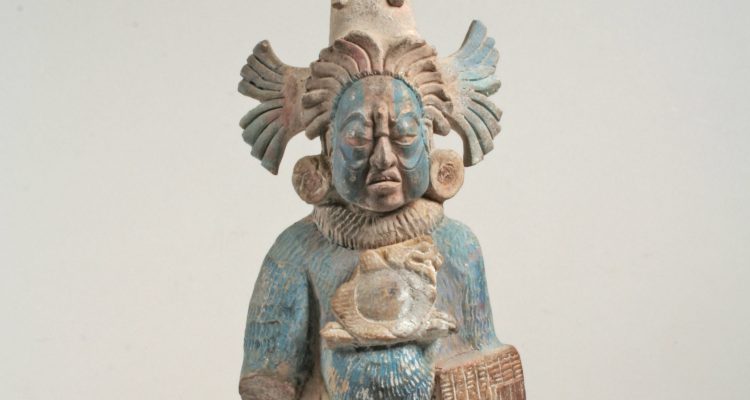Before the Spanish colonization of Central and South America, the continents were inhabited by thriving civilizations. The Mayans, Aztecs and Olmecs were among the many societies that lived in Mesoamerica for centuries before the first Europeans stepped foot on this side of the Atlantic. Much of western culture is well-known and admired around the world; however, in contrast, Pre-Columbian Mesoamerican culture is still not fully understood, even by historians and anthropologists. Their art gives us a partial view into their lives, but these works are hardly known to Americans and Europeans.
This work, a Mayan costumed figure from the sixth or seventh century C.E., which is now housed in the Metropolitan Museum of Art, is one of those generally unknown works. In this ceramic sculpture, a small portly man stands dressed in elaborate costume. His face is old and droopy, displaying wrinkles and sagging eyes, which is a potential sign of wisdom that elders often earned. He wears a tall pointed crown and “earflares,” which are large ornaments worn within the earlobes, much like modern gauges. His cloak is painted blue, while his belt and loincloth are red. This sculpture, however, is not only a figurine, but a functioning whistle. The mouthpiece is attached to the backside of the object, which also acts as a third support so that it may stand erect.
The piece was created in the Jaina style, from the island of Jaina near Campeche, Mexico. With its large belly, sagging jowls and puffy eyes, this figure may be depicting the “Fat God,” a poorly understood religious figure in Mesoamerican culture. However, because scholars are unsure of whether this is actually a deity, most refer to it as the “Fat Man.”
If this was the case, the sculpture would likely be a humorous one, depicting a musical performer or jester-type clown. Its whimsical clothing would support this idea, although it does also include aspects of a warrior, such as the shield in his left hand. Following the notion of humor, this may be ironic, as he is clearly not in fighting shape.
As you can see, this figure is both unidentified and not fully understood. This is the case for a lot of Mesoamerican art–and indigenous art around the globe. While western art – Italian Renaissance paintings, French sculptures, English portraits, etc. – is the most well-known and is readily accessible to the public (standards judged by western cultures to begin with), more attention needs to be paid to these undervalued and ignored works of cultural patrimony.
More funding for research, more prominent exhibition space and more educational initiatives are what these artworks, and the cultures these artworks represent, deserve. Without them, we focus too narrowly on the works of a select group of the world’s population. We center our admiration and wonder on art created mostly by heterosexual, white men. There is plenty of art out there, great art, actually! But, whether or not these works are seen, understood and cherished by the world is dependent on each one of us taking the time to educate ourselves and broaden our horizons. Efforts in the art historical community to better include and appreciate indigenous art have been made, and they are good efforts. But, we have much more to do, and we must not stop or slow down until it is done.


Leave a Reply